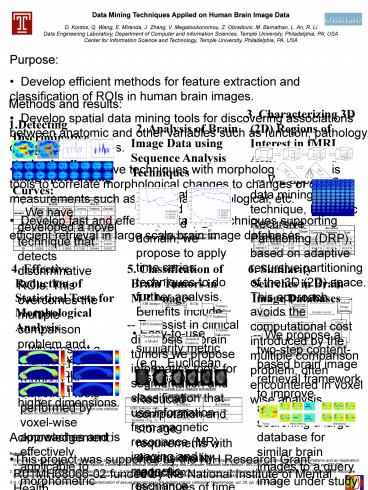NIH-Poster - PowerPoint PPT Presentation
1 / 1
Title:
NIH-Poster
Description:
Develop efficient methods for feature extraction and classification of ROIs in ... anatomic and other variables such as function, pathology, or response to drugs. ... – PowerPoint PPT presentation
Number of Views:84
Avg rating:3.0/5.0
Title: NIH-Poster
1
Data Mining Techniques Applied on Human Brain
Image Data D. Kontos, Q. Wang, E. Miranda, J.
Zhang, V. Megalooikonomou, Z. Obradovic, M.
Barnathan, L. An, R. Li Data Engineering
Laboratory, Department of Computer and
Information Sciences, Temple University,
Philadelphia, PA, USA Center for Information
Science and Technology, Temple University,
Philadelphia, PA, USA
- Purpose
- Develop efficient methods for feature
extraction and classification of ROIs in human
brain images. - Develop spatial data mining tools for
discovering associations between anatomic and
other variables such as function, pathology, or
response to drugs. - Integrate the above techniques with
morphological analysis tools to correlate
morphological changes to changes of other
measurements such as functional, physiological,
etc. - Develop fast and effective database techniques
supporting efficient retrieval in large scale
brain image databases.
A 2-step content-based brain image retrieval
framework
- Acknowledgement
- This project was supported by the NIH Research
Grant R01MH68066-02 funded by the National
Institute of Mental Health.
- References
- D. Kontos, V. Megalooikonomou, D. Prokrajac, A.
Lazarevic, Z. Obradovic, J. Ford, F. Makedon, and
A. J. Saykin, "Extraction of Discriminative
Functional MRI Activation Patterns and an
Application to Alzheimer's Disease," in Proc of
7th International Conference on Medical Image
Computing and Computer Assisted Intervention -
MICCAI, Rennes - St.Malo, France, 2004, pp.
727-735. - V. Megalooikonomou, D. Kontos, D. Pokrajac, A.
Lazarevic, Z. Obradovic, O. Boyko, A. Saykin, J.
Ford, and F. Makedon, "Classification and Mining
of Brain Image Data Using Adaptive Recursive
Partitioning Methods Application to Alzheimer
Disease and Brain Activation Patterns," in Proc.
of Human Brain Mapping (HBM), New York, NY, 2003. - A. Dubb, R. Gur, B. Avants, and J. Gee,
"Characterization of sexual dimorphism in the
human corpus callosum," NeuroImage, vol. 20, pp.
512-519, 2003.































